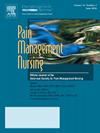Non-Opioid Postoperative Analgesic Options for Pediatric Patients Using Regional Anesthesia
IF 1.6
4区 医学
Q2 NURSING
引用次数: 0
Abstract
We know that exposure to unnecessary opioids can increase risk for changes in the brain and nervous system in children. There is evidence for use of a variety of regional anesthesia options for treating post-operative pain that can be utilized in lieu of or in addition to opioid analgesics in the pediatric population. Acute Pain Teams should utilize various types of pain management options for post-operative patients including multimodal analgesia such as epidural analgesia, peripheral nerve catheters (PNCs), nerve blocks, paravertebral catheters, and wound catheters. These options often lead to reduced use or no use of opioids, which is a great added benefit.
At our institution, anesthesiologists evaluate patients pre-operatively to determine eligibility for regional anesthesia. Eligible patients receive induction of regional anesthesia in the OR and are managed by Pain Team while inpatient. Contraindications include low platelet count, abnormal coagulation studies, compartment syndrome, spinal abnormalities, anticoagulation therapy, and weight under 2 kilograms.
Epidurals are placed by anesthesia and typically stay in for 3-5 days. Caudal epidurals are utilized for NICU patients, often following major abdominal surgeries. They can assist in limiting post-operative mechanical ventilation and continuous opioid infusions. PNCs are frequently used for patients undergoing orthopedic surgeries. They are inserted by anesthesia in the OR and typically removed post-op day five. Patients with PNCs may be discharged home with catheters in place. This helps decrease hospital length of stay and manage pain while at home. Nerve blocks are also performed by anesthesia. They typically provide pain control for 12-24 hours after surgery with various block options in both upper and lower extremities. Wound catheters are inserted in the OR by the surgeon and infuse local anesthetic near the surgical incisions, assisting with surgical incision associated pain. These are a great option for patients ineligible for epidural catheters or for laparoscopic procedures that are converted to open. Our Pain Team manages the medication infusing while it is in place.
Nurses play a vital role in caring for surgical patients and need to understand regional pain management options, recognize side effects, and monitor for adverse outcomes. It's important for Pain Teams to work closely with other surgical specialties to ensure best outcomes and utilize regional analgesia when appropriate.
求助全文
约1分钟内获得全文
求助全文
来源期刊

Pain Management Nursing
医学-护理
CiteScore
3.00
自引率
5.90%
发文量
187
审稿时长
>12 weeks
期刊介绍:
This peer-reviewed journal offers a unique focus on the realm of pain management as it applies to nursing. Original and review articles from experts in the field offer key insights in the areas of clinical practice, advocacy, education, administration, and research. Additional features include practice guidelines and pharmacology updates.
 求助内容:
求助内容: 应助结果提醒方式:
应助结果提醒方式:


